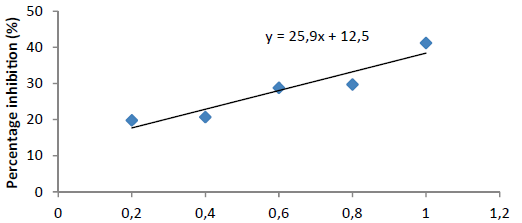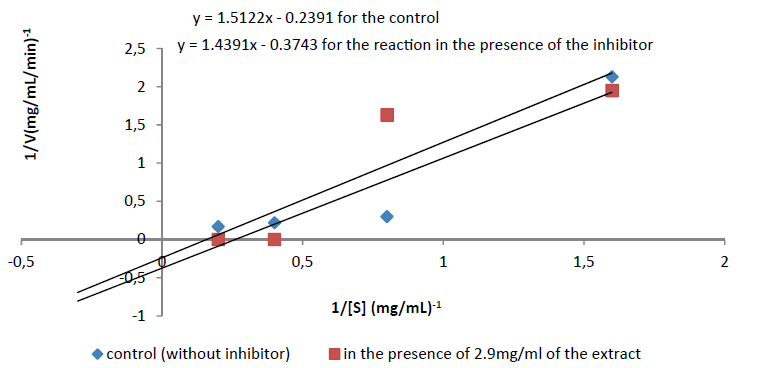INTRODUCTION
Type 2 diabetes is characterized by persistent hyperglycemia due to defects in insulin action, insulin secretion or both resulting in persistently elevated postprandial glucose (1). Postprandial hyperglycemia is a major risk factor for micro- and macrovascular complications associated with diabetes (2, 3) and so controlling postprandial plasma glucose level is critical in the early treatment of diabetes mellitus and in reducing chronic vascular complications (4). Oxidative stress in type 2 diabetics is triggered more by acute glucose fluctuations during the postprandial period, therefore therapy in type 2 diabetes should not only target mean glucose concentrations and hemoglobin A1c levels but should also target acute glucose swings (5, 6). It is therefore imperative to look into treatment strategies for type 2 diabetes that control to the barest minimum acute fluctuations in postprandial glucose and the best target for this is the inhibition of alpha-glucosidase.
Alpha-glucosidases anchored in the mucosal brush border of the small intestine catalyzes the last hydrolytic step of starch and sucrose (7). One of the strategies adopted in the treatment of diabetes mellitus involves inhibition of alpha-glucosidase in the gastrointestinal tract, which results in the retardation of intestinal glucose absorption and lowering of postprandial blood glucose levels (8).
Medicinal plants and their products continue to be important therapeutic aids for alleviating the ailments of humankind (9-12). Herbs for diabetes treatment are not new. Since ancient times, plants and plant extracts were used to combat diabetes. Many traditional medicines in use are derived from medicinal plants, minerals, and organic matter.
Momordica charantia (M. charantia), also known as Bitter melon (“Karela”, Balsam pear, or Bitter gourd), is a popular plant used for the treating of diabetes and diabetic related conditions amongst the indigenous populations of Asia, South America, India, the Caribbean and East Africa (13, 14). M. charantia is one of the plants that have been investigated thoroughly for the treatment of diabetes (15). The traditional use is supported by modern scientific evidence of the beneficial function of M. charantiaas one of the most promising plants for diabetes today (13, 16). Investigation of the traditional uses of M. charantia in India revealed that it is widely used for lowering of blood glucose levels in patients with diabetes (17).
Various animal studies have repeatedly shown hypoglycemic effects of the seeds, fruit pulp, leaves and whole plant of M. charantia in normal animals (18-20). In particular, M. charantia improves glucose tolerance and suppresses postprandial hyperglycemia in rats (21-23). Amongst the main constituents of bitter melon which are responsible for the antidiabetic effects are the triterpenes, (24, 25). The structure of three cucurbitane triterpenoids was determined, as well as two other major compounds that were tested and shown to significantly lower blood glucose levels in diabetic mice (26) but the effect of terpenes from M. charantia on the activity of alpha-glucosidase has not been investigated. Working on this premise, it is therefore important to investigate the effect of terpenes from M. charantia on alpha-glucosidase. This will bring us a step closer to understanding how the compounds found in the plant work and what they act on to elicit their anti-diabetic activity, in this case, reduction of postprandial hyperglycemia.
MATERIALS AND METHODS
Plant collection and preparation
The leaves of Mormodica charantia was collected from Zaria, Kaduna state and was authenticated at the Department of Botany, Faculty of Life Sciences, Ahmadu Bello University, Zaria and a voucher number (VN1139) was obtained. The collected plant sample was rinsed with clean water and air dried at room temperature. The dried samples were pulverized into powder using a laboratory mill, the powder obtained was used to prepare the extracts. Five hundred grams of the plant was weighed and extraction was carried out using the maceration technique. The solvent used for the extraction was methanol. The powdered plant was soaked in methanol for 48 hours at room temperature. The extract was then filtered with Whatman No. 1 filter papers and the filtrate was concentrated using a rotary evaporator. The obtained crude extract was stored in an air-tight bottle.
Determination of alpha-glucosidase inhibition
The effect of the plant extract on α-glucosidase activity was determined according to the method described by Kim et al. (27), with slight modifications. Alpha-glucosidase from Saccharomyces cerevisiae (g0660), REF: AA/Abiola/yakubu/0105/07/13] was used for the assay. The substrate solution (5.0mM) para-nitrophenyl-α-D-glucopyranoside (pNPG) was prepared in 20mM phosphate buffer, pH 6.9. Using dimethyl sulphoxide (DMSO) to dissolve the extract, varying concentrations of the extract solution ranging from 0.2, 0.4, 0.6, 0.8 to 1.0 mg/mL was used for the assay. Then 50 μL of α-glucosidase (1 U/mL) was added to five tubes containing 20 μL of the different concentrations (0.2, 0.4, 0.6, 0.8 and 1 mg/mL) of the extract. After which, 30 μL of 5.0 mM (pNPG) was added to start the reaction. The reaction mixture was incubated at 37˚C for 1 hour and stopped by adding 1 mL of 0.1 M sodium carbonate (Na2CO3). The α-glucosidase activity was determined by measuring the yellow colored para-nitrophenol released from pNPG at 400 nm using a spectrophotometer. The blank solution was prepared by adding the Na2CO3 to the reaction mixture before adding the enzyme. The results were expressed as a percentage of the negative control in which the extract was replaced with DMSO. All the reactions were conducted in triplicates.
Percentage inhibition was calculated as:
Concentrations of extracts resulting in 50% inhibition of enzyme activity (IC50) was determined graphically using the concentration/inhibition plots [28].
Determination of the mode of inhibition of α-glucosidase
The mode of inhibition of the extract was determined according to the method described by Ali et al (29). Briefly, 20 μL of three different concentrations (0 mg/mL, 1.4 mg/mL, 2.9 mg/mL) of the extract was pre-incubated with 40 μL of α-glucosidase solution for 10 mins at 25ºC in three different sets of tubes. In another set of tubes, α-glucosidase was pre-incubated with 20 μL of phosphate buffer (pH 6.9). Then 20 μL of pNPG at increasing concentrations (0.625 - 5mM) was added to all the sets of reaction mixtures to start the reaction. The mixture was then incubated for 1hour at 37°C, and 0.8 mL 0.1 M of Na2CO3 was added to stop the reaction. The amount of reducing sugars released was determined spectrophotometrically using a para-nitrophenol standard curve which was converted to reaction velocities. A double reciprocal plot (1/v versus 1/[S]) where V is reaction velocity and [S] is substrate concentration was plotted. The type (mode) of inhibition of the crude extract on α-glucosidase activity was determined by analysis of the double reciprocal (Lineweaver-Burk) plot using Michaelis-Menten kinetics.
RESULTS
Percentage inhibition of alpha-glucosidase by a terpenoid rich extract of M. charantia
From the Figure 1, it was observed that the inhibition of the enzyme by the extract (though weak) even at high concentrations of 1 mg/mL, was less than 50%. Thus, using the graph equation, the concentration of the extract that can inhibit 50% of the enzyme activity (IC50) was calculated to be 1.45 mg/mL.
Lineweaver - Burk plot for the activity of alpha-glucosidase in the presence of varying concentrations of the terpenoid rich extract of M. charantia
The double reciprocal plot (Lineweaver-Burk plot) showing the activity of alpha-glucosidase in the presence of the extract was shown in Figure 2. This graph is necessary so as to be able to gain an insight into the kind of inhibition the extract exerts on the enzyme. Thus, the terpenoid rich extract of M. charantia is a partially mixed inhibitor of alpha-glucosidase since there is a change in both the Km and the Vmax of the enzyme in the presence of the extract (Figure 2).
DISCUSSION
In order to effectively manage diabetes mellitus, there has to be a close monitoring of the levels of postprandial blood glucose and the most effective way to do this is by regulating the amount of glucose that enters the bloodstream after intake of a meal and an effective way to achieve this is through the inhibition of alpha-glucosidase. The available oral chemotherapeutic drugs available come with a range of uncomfortable side effects such as flatulence, abdominal pain, renal tumors, hepatic injury, acute hepatitis, abdominal fullness and diarrhea (30-31). As a result of this side effects and other constraints; patients now prefer to use locally available herbs to treat diabetes, especially those plant and plant parts that are already consumed as food or food condiments since these plants have been seen to have lower side effects and are quite affordable. Several plants have been reported to have alpha-glucosidase inhibitory activity (32-35). Momordica charantia being one of such plants, also the fact that several types of research (13-17) have shown the potency of the plant in the management of diabetes, it, therefore, justifies the focus of this particular research.
One of the major characteristics of drugs used in the management of Type 2 diabetes is ability to inhibit carbohydrate digesting enzymes (36). The result of the in vitro investigation on the inhibition of alpha-glucosidase activity in the presence of the terpenoids-rich extract of M. charantia showed that a concentration of 1.45 mg/mL of the extract could inhibit 50% of the enzyme activity. This concentration seems to be high when compared to similar researches carried out on the same enzyme but using different plants (37-38). Now the implication of this is that there may be a need for further purification of the extract so as to eliminate all interfering substances and to give the active ingredient a better chance of inhibiting the enzyme. Moreover, this result is not suprising going by the various therapeutic attributes of Momordica charantia (39).
Though the result of the inhibition experiments showed that a high concentration of the extract was needed to inhibit the enzyme; investigations on the mode of inhibition indicated that the extract is a partial mixed-type inhibitor of the enzyme since there was a change in both the Km and Vmax of the enzyme in the presence of the extract. This result may be attributed to the presence of several interfering substances in the extract and a clearer picture of the mode of inhibition of this extract will also be seen upon further purification.

















